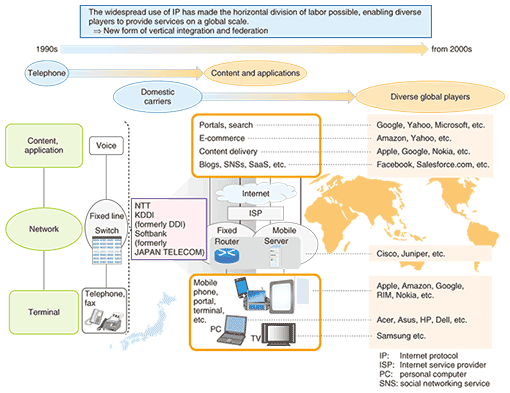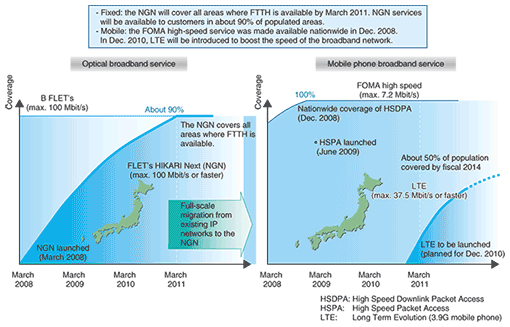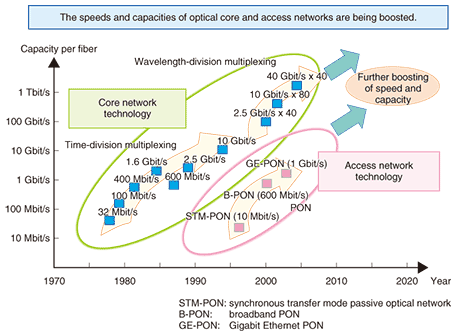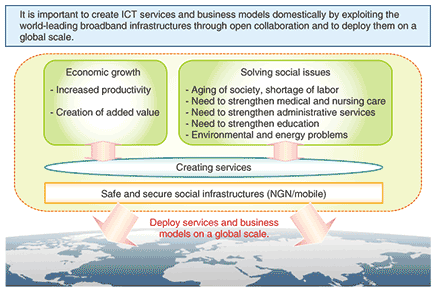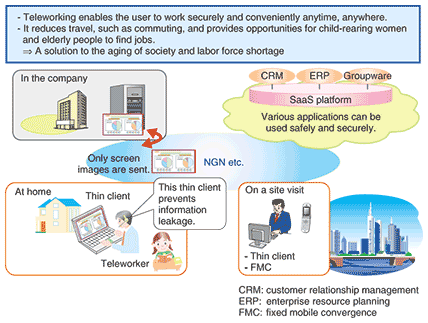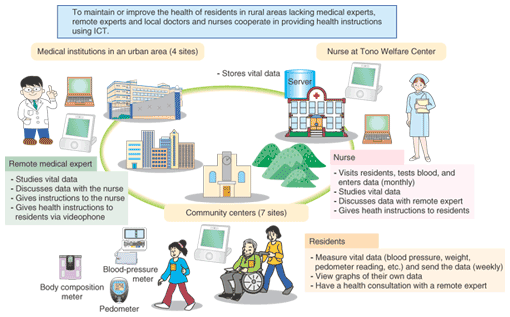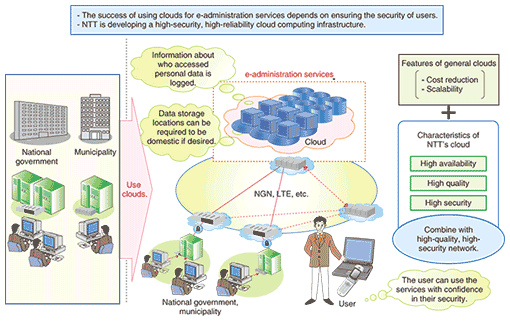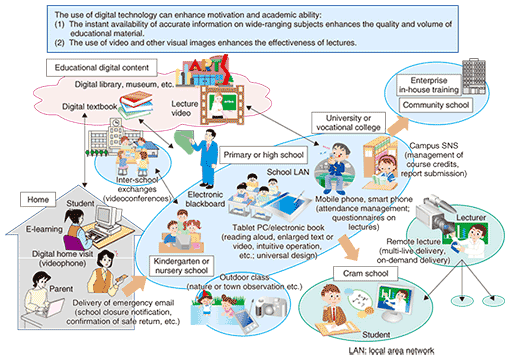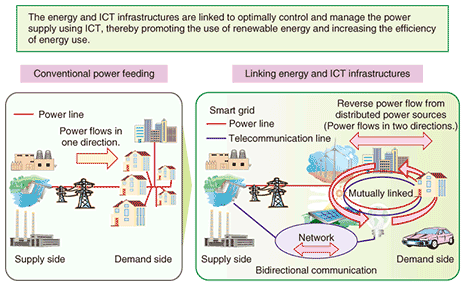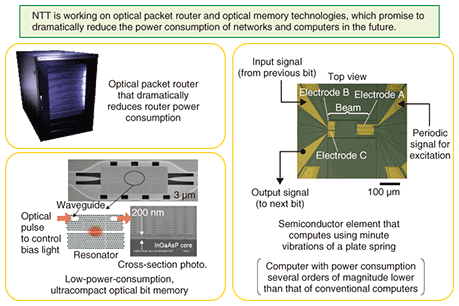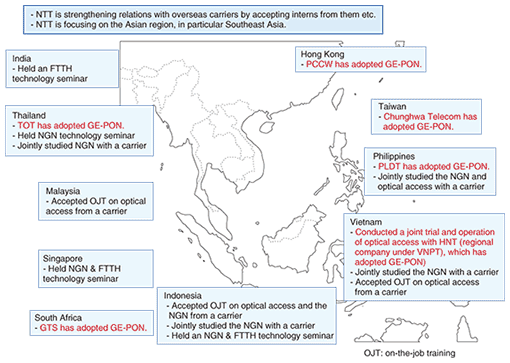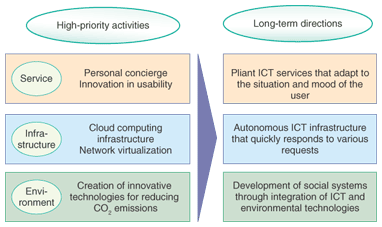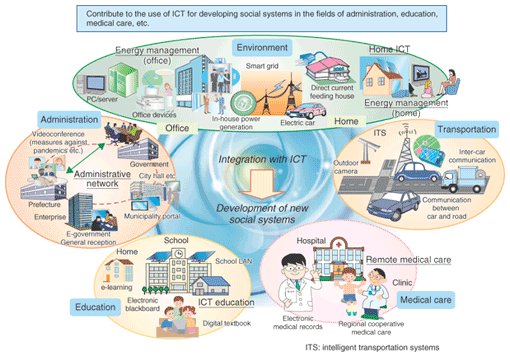 |
|||
|
|
|||
|
Special Feature: Keynote Speeches at NTT R&D Forum 2010 Vol. 8, No. 4, pp. 1–12, Apr. 2010. https://doi.org/10.53829/ntr201004sf1 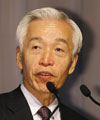 Creation of ICT Services to Solve Social IssuesAbstractThis article introduces NTT’s activities, including those in research and development, for promoting the application of information and communications technology (ICT) in various fields. It is based on the keynote address given in Japanese by Satoshi Miura, President and CEO of NTT, at the NTT R&D Forum 2010 held on February 22–24, 2010. 1. Current social and economic situationsAlthough the worst may be behind us, the economy of Japan is still far from a full recovery. A bleak atmosphere surrounds all aspects of national life, with capital investment by enterprises remaining at a record low level, the unemployment rate showing no signs of recovery, and the issuance of government bonds exceeding tax revenue. On top of this, Japan faces a mountain of interrelated social issues, such as the aging of society and serious problems in the areas of medical and nursing care, education, the environment, and energy. It is high time for the government to launch a national vision and define the nation’s future direction. Enterprises need to take the initiative in actively seeking innovation and striving to achieve growth. In particular, the information and communications technology (ICT) industry, which accounts for one-third of the nation’s economic growth, is playing such a major role in business that it can be considered to be the very heart of business management strategy. Because of this, we are committed to further developing ICT and supporting economic growth and solving social issues by building new business models in collaboration with other industries. 2. Paradigm shifts in ICTThe world of ICT is being rapidly shaped on a global scale by great paradigm shifts. These include the shift to service convergence as seen between telecommunications and broadcasting, between fixed and mobile communications, and between ICT and other industries; the shift from ownership to use, typified by software as a service (SaaS) and cloud computing; and the shift to user-centric services, as represented by social networking services and Twitter. These shifts have brought about a dramatic transformation in the competitive environment of ICT, with a variety of players now competing with each other across the traditional boundaries of industries, across layers, and across national borders (Fig. 1).
Google, Apple, and Amazon are doing business globally with a vertical business model that provides a package of terminals, content, and applications and they are extensively exploring the Japanese market. Amazon has recently expanded its sales by providing a package consisting of a Kindle bundled with the delivery of electronic books. After the end of March 2010, Apple will sell the iPad (Wi-Fi model), another tool for reading electronic books. Apple also plans to combine the iPad with content delivery and will introduce a 3G (third-generation wireless) model of the iPad later in April. 3. Progress in broadband infrastructure developmentAs ICT infrastructures, Japan has both fixed-line and mobile broadband networks that lead the world in terms of low charges, high speed, and high penetration rate (Fig. 2).
Even if we look at the NTT Group alone, our fiber-to-the-home (FTTH) service (called FLET’S HIKARI) covers about 90% of the populated areas of Japan. This service is partially provided over the Next Generation Network (NGN), which features high quality and security. In the arena of mobile services, the FOMA high-speed service is already available nationwide. If we look at all carriers, the number of broadband access lines reached 31.3 million by the end of September 2009. The penetration of broadband access for households is 63%. Of these, 16.52 million are FTTH lines, and the FTTH penetration for households is 33%. The number of mobile phone subscribers has exceeded 100 million. Of these, 95% are 3G users. The 3G penetration for households is as high as 91%, indicating a rapid migration of mobile phone users to broadband access. The abovementioned advanced broadband environment has been the fruit of many years of research and development (R&D) activity (Fig. 3). While the transmission rate of the core network was 32 Mbit/s in the late 1970s, today it is as high as 1.6 Tbit/s thanks to the emergence of wavelength-division multiplexing and optical amplification technologies. The core network is now well equipped to support the delivery of video and other large content items. The access networks have become faster and more economical thanks to R&D of passive optical network (PON) technology.
For mobile phone networks, there have also been intensive efforts to increase the speed and capacity, as shown in Fig. 2. The communication speed of the 3G service was initially 384 kbit/s. In 2008, the maximum communication speed of the downstream link was raised to 7.2 Mbit/s through the use of high-speed downlink packet access (HSDPA), and in June 2009, the maximum upstream link speed was boosted to 5.7 Mbit/s by using high-speed packet access (HSPA). In 2010, we plan to introduce Long Term Evolution (LTE), which is as fast as FTTH. 4. ICT services for solving social issuesIt will become increasingly important to create new services that are useful for everyday life on the basis of safe, secure, and leading-edge broadband networks (Fig. 4). We believe that ICT should contribute not only to the nation’s economic growth through innovations to efforts to solve the social issues that confront Japan, which is sometimes dubbed a “leading country in social problems”. We believe that, by accumulating best practices related to the use of ICT services and business models developed in Japan, Japan can become a “leading country in solving social problems” and that the global expansion of such ICT services and business models will strengthen Japan’s global competitiveness.
4.1 Dealing with aging and labor force shortageWhile job security is a pressing issue in the short term, the aging of society and declining birthrate clearly point to a future in which Japan will face a shortage in the labor force in the medium-to-long term. Therefore, it is important to enable people engaged in child rearing, senior people, and physically challenged people to take up jobs in various ways and thereby help to maintain the vigor of the nation’s economy. In this context, teleworking is expected to become a useful means of making personal life and work compatible with each other, i.e., achieving a good work-life balance. A critical issue for teleworking is how to ensure sufficient security to prevent the leakage of information. A mechanism in which thin clients are used to prevent customer information from being left behind on client terminals has been developed (Fig. 5). And another mechanism that enables business applications to be accessed from anywhere by using SaaS or cloud computing has been implemented. Combined with mobile terminals, such a mechanism enables people at home, or on a visit to another site, to work in the same computing environment as in their office, with a high level of confidence in data security.
The NTT Group offers a wide range of solutions that support teleworking and is also using them for its own employees. 4.2 Reinforcing medical and nursing careIn the field of health and nursing care, the use of ICT will lead to better medical services, such as rapid diagnosis and fewer errors. For example, electronic health records and personal health records can be shared not only within a single hospital but also among different hospitals via a network, while still ensuring security, However, Japan lags behind in this area compared with other industrialized countries. Let us look at the situation in Tono, Iwate Prefecture, which suffers from a shortage of medical doctors (Fig. 6). The city has opened, in each community center, a room where citizens can measure and enter their health data (blood pressure, pedometer measurement, etc.) and receive health advice from local nurses. The room is connected via videophone and mobile phone to remote specialists who can give health instructions to the citizens.
In providing assistance to initiatives such as these, we find that simply providing a network to interconnect sites is inadequate and that it is important to care about how communications are conducted. These initiatives are bearing fruit. They have not only raised the quality of life of citizens, but also enabled community centers to serve as places of human interaction to help invigorate the community. It is important to understand the conditions and needs of each community and design a comprehensive and easy-to-use mechanism accordingly. This is the surest way to make ICT widely accepted. 4.3 Reinforcing administrative servicesICT can be used to seamlessly link various items of administrative information held by the national government and municipalities, thereby making it possible to provide one-stop processing in administrative procedures. If information held by the public sector is linked with that held by relevant institutions in the private sector, the government or municipalities can push important information to the public (Fig. 7).
Today, Japan lags behind in e-administration compared with the USA, Korea, and Scandinavian countries. For example, Korea has been working to harmonize the relevant rules, services, and ICT implementations to offer incentives to the public to use e-administration services. In the case of the e-administration service introduced in Urasoe, Okinawa, Japan, business process reengineering and ICT were used to integrate various conventional systems. As a result, the processing for providing school expense subsidies, which conventionally took 20 steps, is now completed in only two steps, which makes the administrative service very quick to use. As this example shows, the advantages of e-administration include not only improving the efficiency of administrative work but also improving services to citizens. Increasing attention is now being paid to cloud computing as a means for both the central government and municipalities to link their administrative work and provide e-administration services without possessing their own systems (Fig. 8). While cloud computing allows cost reductions and scalability, if it is to be applied to social infrastructures to provide public services, its reliability and security must be raised.
To respond to such needs, the NTT Group is undertaking R&D of a cloud computing infrastructure by combining clouds with high-quality networks, which are the forte of the Group, under the motto of “providing safe and secure clouds”. 4.4 Reinforcing educationAs the aging of society and declining birthrate continue to advance in Japan, a country with scarce natural resources, it is important to strengthen education and develop human resources. We believe that it was the high level of education of the people that enabled Japan to catch up with Western powers relatively rapidly in the late 19th and early 20th centuries, after opening its door to foreign countries in 1868, and quickly achieve economic recovery after being devastated by air raids in World War II. Today, however, Japan is experiencing a range of problems in all stages of education, from home education to primary schools, through universities, and on to training in enterprises. ICT helps to improve the quality of education and expand educational opportunities (Fig. 9). As the saying goes, “a picture is worth a thousand words”. Students in a geography class, for example, can understand better and are more stimulated to study if they can view videos of the places they are learning about.
ICT can also assist home education. For example, students at home can receive detailed lectures, using videos and audios on websites as many times as they want, can have exercises tuned to their weak points, and can motivate themselves by communicating with teachers and other students using blogs. The NTT Group has started an Internet school called “N-Academy” as one of the application services exploiting broadband networks. This school features intense training by distinguished instructors. This has been made possible by the availability of bidirectional broadband communication. The school offers a wide range of courses, from cooking and flower arranging to sports and business-related subjects. 4.5 Protecting the global environmentPrime Minister Hatoyama has announced Japan’s target of reducing its CO2 emissions by 25%. We believe that ICT services will play a vital role in two ways in the efforts to achieve this goal. The first is “Green by ICT”, which means contributing to CO2 emissions reductions by society at large by promoting the use of ICT in various fields of human activity. The second is “Green of ICT”, which means reducing the CO2 originating from ICT systems. (1) Green by ICT An example of ICT contributing to a reduction in electric power consumed by society at large is a smart grid (Fig. 10). By linking the electric power service and telecommunications, we can make the level of power consumption more visible, thus providing motivation to save power, and we can optimize the demand and supply of power, promote the use of renewable energy, and increase efficiency in the use of energy.
NTT is working on Home ICT, which connects many devices at home––not only information devices but also home and health appliances––to the network. The interconnection of these devices and appliances is expected to enhance the effectiveness of smart grids. (2) Green of ICT Let me introduce some examples of advanced R&D activities to reduce the power consumption of ICT equipment (Fig. 11).
NTT is undertaking R&D of optical packet router technology with a view to developing a high-speed, high-capacity optical network in the future. The overall power consumption of the network can be dramatically reduced by reducing the amount of electrical processing in routers. In addition, we have succeeded in developing an optical bit memory, which uses photonic crystals. This ultracompact memory allows integration and operates at low power, so it is expected to pave the way for the development of practical optical memory devices in the future. R&D on a semiconductor device that computes using minute vibrations of a plate spring is also being undertaken. The technology for this device is expected to become a critical component technology for ultralow-power computers. Another important power-saving effort being undertaken by the NTT Group is the initiative called “Green NTT”, which promotes the use of natural energy, especially photovoltaic power generation, to reduce the volume of CO2 emitted in the course of business operations. As of February 1, 2010, about 120 buildings of the NTT Group in different parts of the country are generating a total of 3 MW using natural energy sources. The Group is working to raise this figure to 5 MW by 2012. 4.6 Making ICT safe and secure to useSo far I have described the advantages of using ICT. However, we should not forget that the use of ICT can involve serious risk at various levels, for example, cyber-terrorism launched at the national level, information leakage at the organizational level, and virus infections at the personal level. We believe that it is necessary to take a comprehensive approach to eliminating the downsides of ICT if we are to ensure the sound development of ICT. On the individual and user side, education in cyber-ethics is important to ensure that people can use the Internet safely and securely. On the service provider side, filtering and anti-virus measures have already been implemented. It is due to our keen awareness of the importance of quality and security that the NTT Group is building the NGN. At the national and municipality level, it will be necessary to take wide-ranging initiatives to educate citizens and, in some cases, adopt relevant legal regulations. To ensure the development of ICT, it is essential to take measures that address various aspects of the issue, including technical, regulatory, and ethical aspects, and to develop a mechanism that enables users to fully benefit from ICT with a high level of confidence in security. 5. Global deployment of ICT solutionsTo further promote the economic growth of Japan and support the global activities of enterprises as they confront the saturation of the domestic market, it is important to deploy ICT solutions globally. The NTT Group is providing comprehensive ICT solutions and services to global enterprises on the strength of its accumulated know-how and proven record in Japan. On the R&D front, we are supporting the global activities of the Japanese ICT industry by collaborating with Japanese vendors and overseas carriers to have world-leading technologies developed in Japan adopted as international standards. For example, demand for bendable, small-diameter, low-friction optical cables is very high not only in Japan but also overseas. The development of this product is supporting Japanese manufacturers in expanding their business overseas. In the arena of international standardization activities, which indirectly support the global deployment of our R&D results, many NTT Group employees are working hard in responsible posts. It is also important to form a group of like-minded partners on a global scale and lead the world. Specifically, we are promoting the installation of GE-PON (Gigabit Ethernet passive optical network) for FTTH overseas. We have had technical exchanges with carriers mainly in Southeast Asia, and GE-PON has now been adopted by Chunghwa Telecom (Taiwan), PCCW (Honk Kong), TOT (Thailand), HNT (Vietnam), and GTS (South Africa) (Fig. 12).
6. R&D directions in pursuing the creation of new social systemsFinally, let me touch on the directions in which the NTT Group’s R&D is heading (Fig. 13).
In the area of services, we will advance R&D to provide personalized services tuned to individual users, such as “i-concier” [1], and highly user-friendly services, such as those that assist the elderly and physically handicapped in conducting communication. Our future goal is to provide fine-tuned, personalized, flexible services that take account of the situation and mood of the individual user and translate or complement a user’s requests accordingly before providing the requested service. In the area of infrastructures, we will seek to increase the flexibility and expandability of infrastructures, such as the cloud computing infrastructure and network virtualization. We will undertake R&D to achieve an autonomous ICT infrastructure that can respond quickly to requests from users and service providers by assessing the network status. For example, in the event of a sudden rise in traffic or a failure in the network, the network should immediately establish new routing and continue providing services without interruption. In the area of environmental protection, we will not only press ahead with individual technical innovations, such as direct current power feeding and fuel cells, but also aim to integrate ICT with various environmental technologies in other industries, such as electric cars, through open innovation with a view to developing new social systems and contributing to the efficient control and use of energy. In doing so, we will be committed to basic and leading-edge research, from optical transmission technology to cryptographic theory and nanodevices and from quantum information processing to brain science, in order to sow and grow seeds for next-generation technologies. As we undertake these efforts, including global ones, we aim to achieve a brighter future by pursuing R&D that provides value to people, society, and the planet. We believe that these R&D efforts and the introduction of their results to the market will enable ICT to be incorporated into various fields of human, enterprise, and societal activities, thereby contributing to economic growth and creating new social systems and business models that will help to solve social issues (Fig. 14).
In pursuing these efforts, it is important to take a broad look at entire systems and build into them some mechanisms that make them easy to use from the user’s perspective. This will allow ICT to penetrate deeply into our daily lives and bring benefits to people. In other words, it is important to consider what added value leading-edge technologies can provide to society at large. In this sense, we believe that the role of NTT R&D will continue to grow in importance. In summary, the NTT Group will further develop a safe, secure, open, ubiquitous broadband network, and through collaboration with various parties, create useful new services and contribute to the growth of the economy and the solution of social issues. Reference
|
|||








